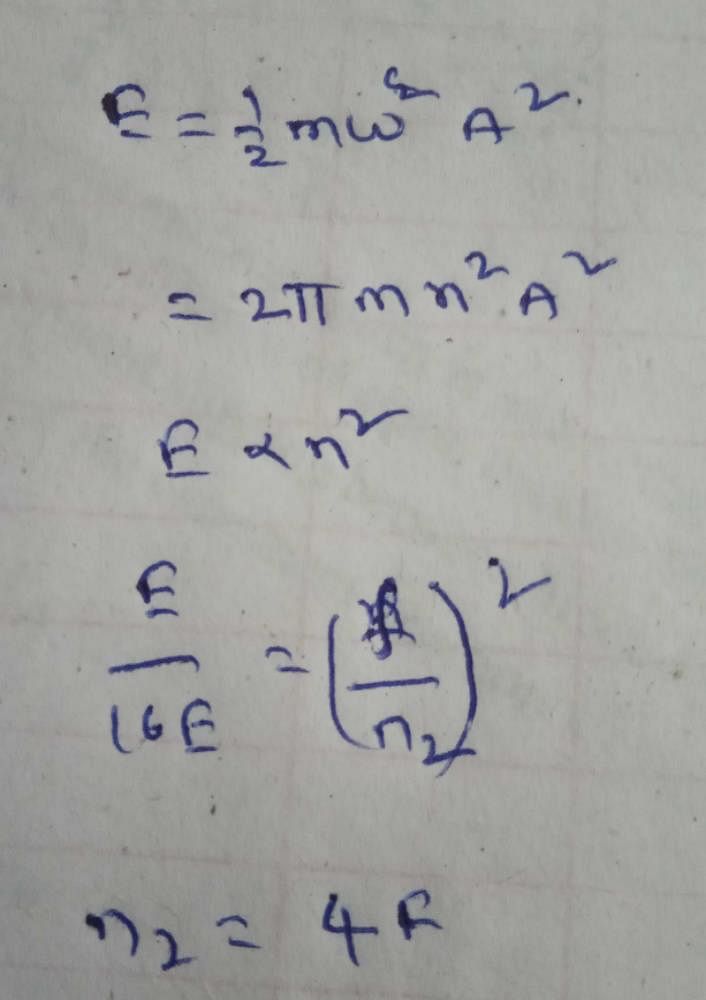NEET Exam > NEET Questions > A SHM is vibrating with certain frequency f i...
Start Learning for Free
A SHM is vibrating with certain frequency f if the energy of shm becomes sixteen times then frequency becomes?
Most Upvoted Answer
A SHM is vibrating with certain frequency f if the energy of shm becom...
Explanation:
The energy of a Simple Harmonic Motion (SHM) is directly proportional to the square of its frequency. In other words, if we increase the energy of the SHM by a certain factor, the frequency will also increase by the square root of that factor.
Let's assume the initial frequency of the SHM is f and the energy becomes 16 times its initial value.
Step 1: Understanding the Relationship between Energy and Frequency
The energy (E) of a SHM is given by the equation:
E = (1/2)kA^2
where k is the spring constant and A is the amplitude of the motion.
The frequency (f) of the SHM is given by the equation:
f = (1/2π)√(k/m)
where m is the mass of the object undergoing SHM.
Step 2: Finding the Relationship between Energy and Frequency
We can express the energy in terms of frequency by substituting the value of k from the frequency equation into the energy equation:
E = (1/2)kA^2 = (1/2)(4π^2m^2f^2)A^2 = 2π^2m^2f^2A^2
Therefore, the energy (E) is directly proportional to the square of the frequency (f):
E ∝ f^2
Step 3: Finding the New Frequency
If the energy of the SHM becomes 16 times its initial value, we can write:
16E = 2π^2m^2f^2A^2
Dividing both sides by 2π^2m^2A^2, we get:
16E/(2π^2m^2A^2) = f^2
Simplifying further, we find:
f = √(16E/(2π^2m^2A^2)) = √(8E/(π^2m^2A^2))
Therefore, the new frequency (f) is equal to the square root of 8 times the initial energy (E) divided by π^2m^2A^2.
Conclusion:
In conclusion, if the energy of a SHM becomes sixteen times its initial value, the frequency will increase by a factor of √8.
Community Answer
A SHM is vibrating with certain frequency f if the energy of shm becom...

Attention NEET Students!
To make sure you are not studying endlessly, EduRev has designed NEET study material, with Structured Courses, Videos, & Test Series. Plus get personalized analysis, doubt solving and improvement plans to achieve a great score in NEET.

|
Explore Courses for NEET exam
|

|
A SHM is vibrating with certain frequency f if the energy of shm becomes sixteen times then frequency becomes?
Question Description
A SHM is vibrating with certain frequency f if the energy of shm becomes sixteen times then frequency becomes? for NEET 2024 is part of NEET preparation. The Question and answers have been prepared according to the NEET exam syllabus. Information about A SHM is vibrating with certain frequency f if the energy of shm becomes sixteen times then frequency becomes? covers all topics & solutions for NEET 2024 Exam. Find important definitions, questions, meanings, examples, exercises and tests below for A SHM is vibrating with certain frequency f if the energy of shm becomes sixteen times then frequency becomes?.
A SHM is vibrating with certain frequency f if the energy of shm becomes sixteen times then frequency becomes? for NEET 2024 is part of NEET preparation. The Question and answers have been prepared according to the NEET exam syllabus. Information about A SHM is vibrating with certain frequency f if the energy of shm becomes sixteen times then frequency becomes? covers all topics & solutions for NEET 2024 Exam. Find important definitions, questions, meanings, examples, exercises and tests below for A SHM is vibrating with certain frequency f if the energy of shm becomes sixteen times then frequency becomes?.
Solutions for A SHM is vibrating with certain frequency f if the energy of shm becomes sixteen times then frequency becomes? in English & in Hindi are available as part of our courses for NEET.
Download more important topics, notes, lectures and mock test series for NEET Exam by signing up for free.
Here you can find the meaning of A SHM is vibrating with certain frequency f if the energy of shm becomes sixteen times then frequency becomes? defined & explained in the simplest way possible. Besides giving the explanation of
A SHM is vibrating with certain frequency f if the energy of shm becomes sixteen times then frequency becomes?, a detailed solution for A SHM is vibrating with certain frequency f if the energy of shm becomes sixteen times then frequency becomes? has been provided alongside types of A SHM is vibrating with certain frequency f if the energy of shm becomes sixteen times then frequency becomes? theory, EduRev gives you an
ample number of questions to practice A SHM is vibrating with certain frequency f if the energy of shm becomes sixteen times then frequency becomes? tests, examples and also practice NEET tests.

|
Explore Courses for NEET exam
|

|
Suggested Free Tests
Signup for Free!
Signup to see your scores go up within 7 days! Learn & Practice with 1000+ FREE Notes, Videos & Tests.























